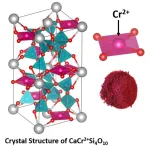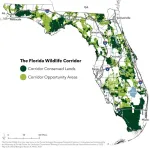(Press-News.org) CORVALLIS, Oregon – An Oregon State University researcher who made color history in 2009 with a vivid blue pigment has developed durable, reddish magentas inspired by lunar mineralogy and ancient Egyptian chemistry.
Mas Subramanian, distinguished professor of chemistry, and collaborators at OSU report the findings of the study, funded by the National Science Foundation, in the journal Chemistry of Materials.
The new pigments, which could be used as energy-efficient coatings for vehicles and buildings, are based on divalent chromium, Cr2+, and are the first to use it as a chromophore; chromophores are the parts of a molecule that determine color by reflecting some wavelengths of light while absorbing others.
“To date, no earth-based mineral has been reported to contain chromium in the divalent state as one of the components,” said Subramanian, the Milton Harris Professor of Materials Science in the OSU College of Science. “However, the analysis of lunar mineral samples collected from Apollo missions showed the occurrence of chromium in the divalent state.”
Divalent chromium has the same number of unpaired electrons as trivalent manganese, the chromophore responsible for the intense color of YInMn blue, which Subramanian’s team discovered 15 years ago. The Shepherd Color Company licensed YInMn blue for use in a wide range of coatings and plastics, and it also inspired a new Crayola crayon color: Bluetiful.
When YInMn blue was discovered, researchers had been experimenting with new materials that could be used in electronics applications and mixed manganese oxide – which is black in color – with other chemicals, then heated them in a furnace to nearly 2,400 degrees Fahrenheit.
One of their samples turned out to be a brilliant blue, named YInMn blue after the component elements yttrium, indium and manganese. It was the first blue pigment discovery in two centuries and a huge advance in safety and durability as well as vividness.
In the new study, Subramanian, research associate Jun Li and graduate student Anjali Verma were inspired by the divalent copper that serves as a chromophore in Egyptian blue, which is the world’s first known synthetic pigment and dates to more than 5,000 years ago.
The researchers replaced the divalent copper in Egyptian blue with divalent chromium, leading to durable, reddish magenta pigments. To stabilize the divalent chromium on Earth, researchers maintained high temperatures, almost 2,500 degrees Fahrenheit, under high vacuum during the synthesis that started from chromium metal, chromium trioxide and other chemicals.
“Most of the magenta-colored pigments used today are organic chemicals and suffer from stability issues when exposed to ultraviolet rays and heat from the sun because they can break down organic chemical bonds,” Subramanian said. “Inorganic magenta pigments are rare, and most require a significant amount of cobalt salts that are hazardous to both humans and the environment.”
The magenta pigments developed by OSU researchers are thermally and chemically inert because of their high preparation temperature and remain unaltered structurally and optically upon exposure to acid and alkali, the authors note.
In addition, unlike pigments that contain cobalt, the chromium-based magenta pigments are highly reflective of heat from the sun – meaning they have a cooling property that would lead to energy savings for cars and structures coated in them.
“Most pigments are discovered by chance,” Subramanian said. “The reason is because the origin of the color of a material depends not only on the chemical composition but also on the intricate arrangement of atoms in the crystal structure. So someone has to make the material first in a laboratory, then study its crystal structure thoroughly to explain the color.”
Despite recent advances in quantum mechanical theories and computational methods, predicting a crystal structure that will produce an intense inorganic pigment of a desired color is still elusive, he added.
“We got lucky the first time with YInMn blue, and now we are coming up with some fundamental chemical and crystal structural design principles to rationally create new pigments,” he said. “Determining the key structural ingredients required for making vivid colors should allow for shorter times between pigment discoveries. Science doesn't always follow a prescribed path, but we’re exploring pigments with divalent chromium as a chromophore in diverse coordination environments in crystal structures of various inorganic compounds.”
The NSF funding for the just-published study was a special grant earmarked for high-risk, high-reward research. The grant is known by the acronym EAGER, which stands for Early Concepts Grants for Exploratory Research.
END
Oregon State researchers advance pigment chemistry with moon-inspired reddish magentas
2024-04-16
ELSE PRESS RELEASES FROM THIS DATE:
Conformity to masculine gender norms is linked to muscle dysmorphia among young people
2024-04-16
Toronto, ON - A new research study out of the University of Toronto sheds light on the intricate relationship between conformity to masculine gender norms and muscle dysmorphia symptomatology among a diverse sample of Canadian adolescents and young adults. The study entitled "Exploring the Association Between Conformity to Masculine Gender Norms and Muscle Dysmorphia Symptomatology in a Gender-Diverse Canadian Population" was recently published in the journal Sex Roles.
Muscle dysmorphia, characterized ...
EuBiologics’ simplified OCV achieves WHO PQ
2024-04-16
- Euvichol-S, developed jointly by EuBiologics and IVI, improves productivity by approximately 40% over Euvichol-Plus®
- Production and supply of Euvichol-S expected to help address cholera vaccine shortages
April 15, 2024, SEOUL, Republic of Korea – EuBiologics and the International Vaccine Institute (IVI) announced that Euvichol-S, an improved oral cholera vaccine (OCV) developed jointly by EuBiologics and IVI, has achieved World Health Organization prequalification (PQ). Euvichol-S ...
GPT-4 matches radiologists in detecting errors in radiology reports
2024-04-16
OAK BROOK, Ill. – Large language model GPT-4 matched the performance of radiologists in detecting errors in radiology reports, according to research published today in Radiology, a journal of the Radiological Society of North America (RSNA).
Errors in radiology reports may occur due to resident-to-attending discrepancies, speech recognition inaccuracies and high workload. Large language models, such as GPT-4, have the potential to enhance the report generation process.
“Our research offers a novel examination of the potential of OpenAI’s GPT-4,” said study lead author Roman J. Gertz, M.D., resident in the Department ...
SwRI to discuss automotive decarbonization, automation at SAE International’s WCX™ 2024
2024-04-16
SAN ANTONIO — August 16, 2024 —Southwest Research Institute helps the automotive industry transition to smart, sustainable mobility, developing hybrid, electric and hydrogen solutions and applying artificial intelligence for safe, eco-friendly driving. SwRI engineers will be in Detroit April 16-18 to share their expertise at the 2024 SAE International WCX™ World Congress Experience.
WCX invites mechanical, electrical and software engineers working in mobility from around the world to share new knowledge and advancements.
“The automotive and transportation sectors are going through tremendous change and challenges as they navigate ...
From a cryptic genetic element in the human gut to a sensitive biomarker
2024-04-16
A component of the human intestinal flora that has been little studied to date is the focus of a new study. Plasmids are small extrachromosomal genetic elements that frequently occur in bacterial cells and can influence microbial lifestyles – yet their diversity in natural habitats is poorly understood. An international team led by Prof. Dr. A. Murat Eren from the Helmholtz Institute for Functional Marine Biodiversity at the University of Oldenburg (HIFMB) reports in the science journal Cell, a mysterious plasmid, is one of the most numerous genetic elements in the human gut that could potentially serve as a powerful biomarker for identifying ...
Researchers can help shipowners achieve ambitious climate targets
2024-04-16
Shipowners around the world are in a very difficult position, because they are having to order new ships now that will run on fuel and technologies that are not yet fully developed.
A new study suggests that ammonia could be a smart and energy-efficient fuel in the race to achieve net zero in shipping. Researchers at the Department of Industrial Economics and Technology Management (IØT) and the Department of Marine Technology (IMT) at the Norwegian University of Science and Technology (NTNU) ...
Florida Wildlife Corridor eases worst impacts of climate change
2024-04-16
From rising temperatures and altered precipitation patterns to intense weather events such as hurricanes, Florida is experiencing significant climate-related challenges in tandem with skyrocketing insurance rates. As the state’s population continues to surge by 1,000 new residents a day, it is projected to lose 3.5 million acres of land to development by 2070, threatening Florida’s future ability to maintain biodiversity and ecosystem services.
A first-of-its-kind study highlights how Florida can buffer itself against both climate change ...
Creating an island paradise in a fusion reactor
2024-04-16
In their ongoing quest to develop a range of methods for managing plasma so it can be used to generate electricity in a process known as fusion, researchers at the U.S. Department of Energy’s (DOE) Princeton Plasma Physics Laboratory (PPPL) have shown how two old methods can be combined to provide greater flexibility.
While the two methods – known as electron cyclotron current drive (ECCD) and applying resonant magnetic perturbations (RMP) – have long been studied, this is the first time researchers have simulated how they can be used together to ...
Field-margin wetlands alone can’t fix the Gulf of Mexico’s dead zone
2024-04-16
Each summer, a hypoxic dead zone forms in the Gulf of Mexico, making some marine habitats unlivable. The dead zone is caused by nutrients—primarily from agricultural fertilizers—flowing into the Gulf from the Mississippi River. Restoring wetlands at field margins has been proposed to intercept some of the runoff, as wetland plants and soils are capable of absorbing nutrients like a living sponge. But estimates of nutrient removal by restored wetlands have varied widely. Shan Zuidema and colleagues took a whole-system approach to modeling the potential for wetlands to ameliorate the flow of nitrate to the ...
Research has lost none of its innovative drive
2024-04-16
A high-profile study made headlines in 2023 stating that the scientific and innovation system is producing less and less completely new knowledge. Researchers at the University of Basel are now refuting this claim, at least for patents: It is based on a measurement error.
The discovery of mRNA in the 1960s was groundbreaking. Suddenly there were completely new findings that ushered in new developments. This kind of discovery is described as “disruptive”. In contrast, research findings are “consolidating” when they build upon existing knowledge. They are also important, as the example of the ...






